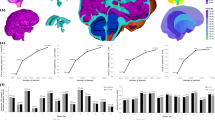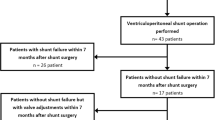Abstract
The authors describe a follow-up to a case of a 19-year-old female with shunted aqueductal stenosis who presented with low-pressure hydrocephalus during a shunt malfunction. Shortly after management with CSF drainage at negative pressure, a magnetic resonance elastography scan was performed and revealed very low brain stiffness (high compliance). Here we present the case of the same patient seen 2 years later, now 21 years old, who again received a magnetic resonance elastography scan after receiving treatment for another shunt malfunction, this time with high intracranial pressure. This scan revealed recovery of brain stiffness to a near normal value for the patients’ age. This observation suggests the low brain stiffness observed during the low-pressure hydrocephalus event is reversible. The authors discuss these findings in relation to biomechanical hypotheses of low-pressure hydrocephalus.


Similar content being viewed by others
Abbreviations
- CSF:
-
Cerebrospinal fluid
- LPH:
-
Low-pressure hydrocephalus
- MRE:
-
Magnetic resonance elastography
References
Pang D, Altschuler E (1994) Low-pressure hydrocephalic state and viscoelastic alterations in the brain. Neurosurgery. 35(4):643–656. https://doi.org/10.1227/00006123-199410000-00010
Strand A, Balise S, Leung LJ, Durham S (2018) Low-pressure hydrocephalus: a case report and review of the literature. World Neurosurg 109:e131–e135. https://doi.org/10.1016/j.wneu.2017.09.120
Akins PT, Guppy KH (2011) The Genesis of Low Pressure Hydrocephalus 15:461–468. https://doi.org/10.1007/s12028-011-9543-6
Lesniak MS, Clatterbuck RE, Rigamonti D, Williams MA (2002) Low pressure hydrocephalus and ventriculomegaly: hysteresis, non-linear dynamics, and the benefits of CSF diversion. Br J Neurosurg 16(6):555–561. https://doi.org/10.3109/02688690209168360
Dias MS, Li V, Pollina J (1999) Low-pressure shunt “malfunction” following lumbar puncture in children with shunted obstructive hydrocephalus. Pediatr Neurosurg 30(3):146–150. https://doi.org/10.1159/000028783
Vassilyadi M, Farmer J-P, Montes JL (1995) Negative-pressure hydrocephalus. J Neurosurg 83(C):486–490
Rekate HL (2019) Low or negative pressure hydrocephalus demystified. World Neurosurg 128:287–288. https://doi.org/10.1016/j.wneu.2019.05.032
Olivero WC, Wszalek T, Wang H, Farahvar A, Rieth SM, Johnson CL (2016) Magnetic resonance elastography demonstrating low brain stiffness in a patient with low-pressure hydrocephalus: case report. Pediatr Neurosurg 51(5):257–262. https://doi.org/10.1159/000445900
Johnson CL, Holtrop JL, McGarry MDJ et al (2014) 3D multislab, multishot acquisition for fast, whole-brain MR elastography with high signal-to-noise efficiency. Magn Reson Med 71(2):477–485. https://doi.org/10.1002/mrm.25065
McGarry MDJ, Van Houten EEW, Johnson CL et al (2012) Multiresolution MR elastography using nonlinear inversion. Med Phys 39(10):6388–6396. https://doi.org/10.1118/1.4754649
Johnson CL, Schwarb H, McGarry MDJ et al (2016) Viscoelasticity of subcortical gray matter structures. Hum Brain Mapp 37(12):4221–4233. https://doi.org/10.1002/hbm.23314
Hiscox LV, Johnson CL, McGarry MDJ et al (2018) High-resolution magnetic resonance elastography reveals differences in subcortical gray matter viscoelasticity between young and healthy older adults. Neurobiol Aging 65:158–167. https://doi.org/10.1016/j.neurobiolaging.2018.01.010
Hiscox LV, Johnson CL, Barnhill E, McGarry MDJ, Huston J 3rd, van Beek EJR, Starr JM, Roberts N (2016) Magnetic resonance elastography (MRE) of the human brain: technique, findings and clinical applications. Phys Med Biol 61(24):R401–R437. https://doi.org/10.1088/0031-9155/61/24/R401
Murphy MC, Huston J, Ehman RL (2019) MR elastography of the brain and its application in neurological diseases. Neuroimage. 187:176–183. https://doi.org/10.1016/j.neuroimage.2017.10.008
Shapiro K, Marmarou A, Shulman K (1980) Characterization of clinical CSF dynamics and neural axis compliance using the pressure-volume index: I. the normal pressure-volume index. Ann Neurol 7(6):508–514. https://doi.org/10.1002/ana.410070603
Arani A, Min HK, Fattahi N, Wetjen NM, Trzasko JD, Manduca A, Jack CR Jr, Lee KH, Ehman RL, Huston J III (2018) Acute pressure changes in the brain are correlated with MR elastography stiffness measurements: initial feasibility in an in vivo large animal model. Magn Reson Med 79(2):1043–1051. https://doi.org/10.1002/mrm.26738
Kolipaka A, Wassenaar PA, Cha S, Marashdeh WM, Mo X, Kalra P, Gans B, Raterman B, Bourekas E (2018) Magnetic resonance elastography to estimate brain stiffness: measurement reproducibility and its estimate in pseudotumor cerebri patients. Clin Imaging 51(February):114–122. https://doi.org/10.1016/j.clinimag.2018.02.005
Hatt A, Cheng S, Tan XK, Sinkus R, Bilston LE (2015) MR elastography can be used to measure brain stiffness changes as a result of altered cranial venous drainage during jugular compression. Am J Neuroradiol 36(10):1971–1977. https://doi.org/10.3174/ajnr.A4361
Funding
The Carle Neuroscience Institute of the Carle Foundation Hospital provided support for this research.
Author information
Authors and Affiliations
Contributions
WCO conceived the research; WCO, AB, TMW, and BPS collected the data; CLJ analyzed the data; WCO, AB, and CLJ wrote the manuscript; and all authors edited and approved the final manuscript.
Corresponding authors
Ethics declarations
Statement of ethics
This research was performed ethically in accordance with the World Medical Association Declaration of Helsinki. The Institutional Review Board of Carle Foundation Hospital approved this research. The patient provided informed, written consent to participate in this research.
Disclosure statement
The authors report no conflicts of interest regarding the material presented in this work.
Additional information
Publisher’s note
Springer Nature remains neutral with regard to jurisdictional claims in published maps and institutional affiliations.
Rights and permissions
About this article
Cite this article
Olivero, W.C., Biswas, A., Wszalek, T.M. et al. Brain stiffness following recovery in a patient with an episode of low-pressure hydrocephalus: case report. Childs Nerv Syst 37, 2695–2698 (2021). https://doi.org/10.1007/s00381-020-04922-x
Received:
Accepted:
Published:
Issue Date:
DOI: https://doi.org/10.1007/s00381-020-04922-x




